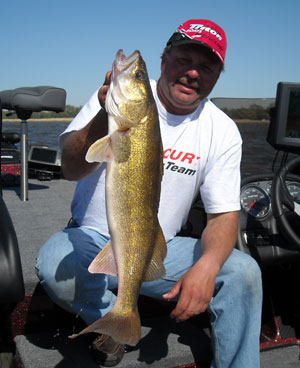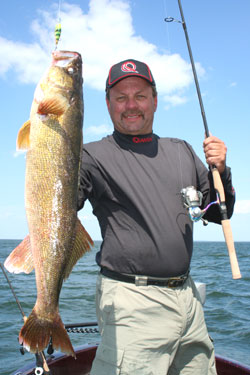
You can burn a lot of natural resources this time of year searching for walleyes.
The spawn is long past, and the fish are scattering throughout our rivers, lakes and reservoirs rebuilding their strength by feeding aggressively. Find the food sources and you will find cooperative walleyes, but that can be a here-today, gone-tomorrow proposition. I like to recycle a pattern that has served me well over the years. When I get the opportunity in May and early June, I go green, as in vegetation. No matter where you like to fish, walleyes will make use of the weeds at some point, and those are some of the first places I point my Triton 215.
The reason walleyes and weeds go hand-in-hand are simple. Weeds serve as nurseries for all kinds of forage. Young crayfish, grubs, salamanders, frogs, baitfish and young gamefish can find the nourishment they need while also using the aquatic forest to hide from predators. Opportunistic walleyes follow.
You probably won’t find great numbers of trophy walleyes in the weeds, at least not during daylight hours, but you will find plenty of fish up to four or five pounds. And where there’s one walleye, there are usually quite a few, which can make for some consistent and exciting action. Good weeds can be found in a variety of depths. Don’t be afraid to go as shallow as 3-4 feet. My general rule is if I can see the bottom, I’m too shallow. Good weeds aren’t hard to find, either. Today’s GPS systems, like the Humminbirds I use, are pre-loaded with detailed maps that show everything from contours to sand, rock, rubble and weeds. In general, look for emerging weeds that are green and healthy.
It doesn’t seem to matter if it’s sunny or cloudy. I’ve found cooperative walleyes in the weeds in both situations. Wind, on the other hand, can be a negative factor. It bends the weeds over, which makes them more difficult to fish, and it also seems to spook the fish. On the other hand, the residual effect of the wind can work to your advantage. Look for weedy areas that have been exposed to the win and check them out once it subsides. If the water’s not too soiled and murky but slightly stained and stirred, it can create a good bite. Overall, the more consistent the weather pattern, the more consistent the weed bite.
This style of fishing is an approach that also lends itself to a variety of presentations. Jigs, crankbaits and even spinner rigs come into play, depending on the conditions and the development of the vegetation. Dipping and flipping jigs is by far my favorite. It’s hard to top the rush you get when you flip a small jig into an opening in the underwater jungle and your rod doubles over while an angry walleye rips through the shallows.

A 1/16th-ounce round head jig is always a good choice. You can tip it with a piece of nightcrawler, a leech or even a minnow early in the weed season. You can also try small plastic grubs or ringworms. Fin-Tech’s Title SHot Shaky Jig is a good option for some plastics, while the Nuckle Ball Jig, which features a snag-free design, can be used with a half-crawler or plastic. I like a medium-action, 7-foot rod for both its length and its quick tip. Maneuver your boat to where the weed growth begins to thicken, and flip or dip your jig into the pockets of open water. If you don’t get bit right away, move on to the next opening. These fish don’t seem to be affected by the presence of a boat. I’ve caught hundreds in 4-5 feet of water right under my Triton.
Larger expanses of weeds may require a more aggressive search approach. That’s where minnow-imitating, shallow-running crankbaits can be deadly. It’s a good method for working sparse vegetation or probing the edges of a weed bed, as well as areas where you can work them just above the tops of the weeds.
Look for something different in the contour, such as a cup, transition or creek mouth. Ticking an occasional weed often triggers violent strikes. Once you contact fish, you can slow down and work the denser vegetation in the area with jigs. Trolling cranks or spinner rigs is a good option for large, relatively straight stretches of weeds or for working the edges where the growth is sporadic. Depending on water clarity, some weed growth also occurs in depths where it isn’t practical to dip jigs. The vegetation can be 4-5 feet beneath the surface, and that’s when a shallow-running crank or a spinner rig tipped with a crawler often excels. I like to troll rigs with no weight or just a small bullet-style weight on Off-Shore Planer Boards to get them away from the boat. If there are detached weeds or other debris in the water, a barrel swivel a few feet ahead of your crank or rig can help keep the business end of your presentation clean.
Whether I’m jigging, cranking or trolling, my MinnKota Terrova 101 is a key. Powered by Optima batteries, it gives me the stealth to get into the thick of things and the power to troll quietly over the top or around the edges of the weeds. Stay mobile when you’re working the weeds. Rarely have I caught more than 4-5 fish in a small area. Usually, I find them in small groups scattered throughout a large area, although it seems like they do key in on the same depths. If they’re in weeds that are five feet deep, often they’ll be in another weedbed elsewhere at the same depth. When the bite dies, try making larger circles in the area to see if you can reconnect with any fish that may have spooked from the area. And if that doesn’t work, move on to a new patch of vegetation and give your other spot a chance to settle down and reload. You may also find that the bite is best in the morning in one area but the afternoon or evening in another.
Go green this spring. It’ll grow on you.










